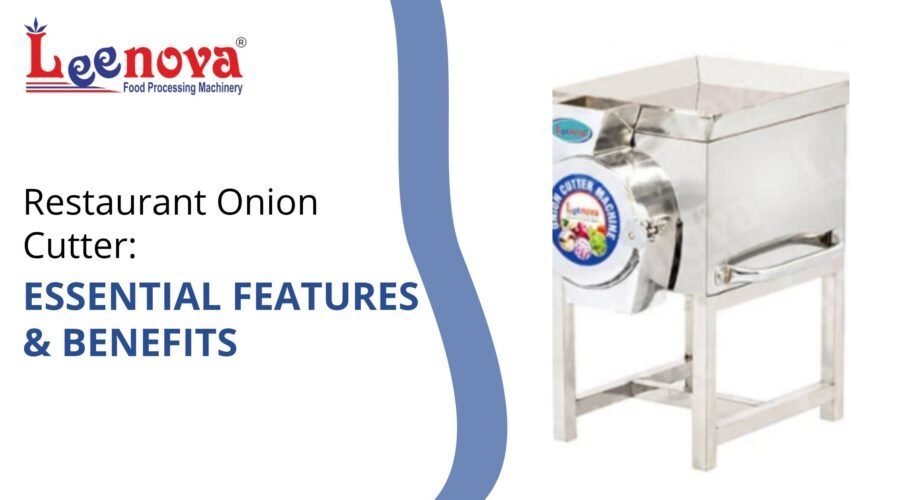Manual onion cutting in restaurant kitchens costs ₹45-60 per hour in labor for a task that triggers eye irritation, increases injury risk, and produces inconsistent cuts. A chef cutting 30 kg of onions manually spends 2.5-3 hours on prep work, often while tears stream down their face. Research shows that 67% of kitchen knife injuries involve onion and vegetable prep, with most occurring during repetitive cutting tasks. A commercial onion cutter eliminates these problems entirely. As a food processing equipment manufacturer since 2006, we design onion cutters that process 25-200 kg per hour with uniform cuts, zero eye irritation, and minimal injury risk. This guide explains how restaurant onion cutters work, essential features that matter, capacity matching for different operations, safety benefits, and how the investment transforms daily kitchen workflows.
Essential Features That Define Quality
Stainless Steel Construction
Food-grade stainless steel construction prevents rust, corrosion, and metal contamination in food contact areas. SS 304 or SS 202 grade meets FSSAI standards and passes health inspections consistently.
The cutting chamber, blades, and discharge chute require stainless steel. Frame components can use mild steel with protective coating to balance cost and durability.
Stainless steel machines clean faster and maintain hygiene standards during high-volume service. A 5-minute rinse removes onion residue completely, while MS components require scrubbing and develop odor retention over time.
Blade Design and Configuration
The number of blades determines cut size and output texture. An 8-blade configuration produces 8mm cubes suitable for gravies, curries, and sautéed preparations. Fewer blades create larger chunks for grilled or roasted applications.
Blade sharpness affects cutting quality and machine load. Sharp stainless steel blades slice cleanly through onion layers without crushing or bruising. Dull blades mash onions into pulp and strain the motor.
Replaceable blade assemblies extend machine life. When blades dull after 6-12 months of daily use, swapping the assembly takes 10 minutes and costs ₹800-1,200 versus replacing the entire machine.
Motor Power and Capacity Match
0.5 HP motors handle 25-30 kg per hour, suitable for small restaurants and cafes serving 50-80 covers daily. These compact units weigh 25-28 kg and fit on standard prep counters.
1 HP motors process 100-150 kg per hour for mid-sized restaurants, hotels, and catering operations. The increased power handles continuous operation during peak prep hours without overheating.
Single-phase 220V power makes these machines compatible with standard kitchen electrical systems. No special wiring or three-phase installation needed, reducing setup costs.
How Onion Cutters Transform Operations
Time Savings That Compound Daily
Manual onion cutting takes 5-6 minutes per kilogram with a sharp knife and proper technique. A 1 HP onion cutter processes the same kilogram in 24-36 seconds. That’s 8-10 times faster than hand cutting.
For a restaurant cutting 40 kg daily, manual prep takes 3.5-4 hours. A machine completes the task in 24-30 minutes. That’s 3 hours of labor freed for cooking, plating, and service tasks.
The time savings multiply across multiple prep items. Most restaurants cut onions, tomatoes, ginger, and chilies daily. A versatile cutter handles all four, saving 6-8 hours of combined prep time.
Cut Uniformity and Cooking Consistency
Machine cutting produces pieces within 1-2mm variance. Manual cutting creates 5-8mm variance even with skilled chefs. Uniform pieces cook at the same rate, preventing some from burning while others stay raw.
This consistency matters most in curry bases and sauces where uneven onion pieces create texture problems. Large chunks stay crunchy while small pieces disintegrate, affecting mouthfeel and customer perception.
Plating presentation improves with uniform cuts. Garnishes and toppings look professional when every piece matches in size and shape, elevating dish appearance without extra effort.
Eye Irritation Elimination
Onion cutting releases sulfur compounds that trigger eye irritation. Chefs experience burning, tearing, and temporary vision blur that slows prep work and creates discomfort.
Enclosed cutting chambers contain these compounds during machine operation. The onion never contacts open air until after cutting completes, reducing vapor release by 90-95%.
Kitchen staff productivity increases when eye irritation disappears. No more pausing to wipe tears, rinsing eyes, or working with blurred vision during critical prep hours.
Safety Benefits and Injury Prevention
Knife Injury Reduction
Manual cutting requires 200-300 knife strokes per kilogram of onions. Each stroke carries injury risk, especially during the 2-3 hour prep sessions common in busy kitchens.
Repetitive knife work causes fatigue that increases accident likelihood. Tired hands slip more easily, producing the cuts and lacerations that account for 67% of kitchen injuries.
Onion cutters eliminate 95% of knife contact with this task. The operator feeds whole onions into the hopper while the machine handles the cutting action, keeping hands away from blades.
Ergonomic Advantages
Standing over a cutting board for 2-3 hours causes back strain, shoulder tension, and wrist fatigue. These repetitive stress injuries accumulate over months and years of kitchen work.
Machine cutting requires 30-40 minutes of work in the same position. The reduced time lowers physical strain and prevents long-term injury that leads to medical leave and replacement costs.
Capacity Selection and ROI
Matching Machine to Operation
Calculate actual daily onion usage over 2-3 weeks to determine accurate capacity needs. A restaurant using 35-40 kg daily needs at least a 100 kg/hr machine to complete cutting in 25-30 minutes including setup and cleaning.
Overbuying capacity wastes money. A 200 kg/hr industrial cutter costs 2.5-3 times more than a 100 kg/hr model but provides no benefit to operations processing 40 kg daily.
Peak day planning creates false requirements. Base capacity on average daily volume, not the busiest service day of the year. Occasional manual cutting costs less than oversized equipment.
Cost Recovery Timeline
A ₹13,000 onion cutter processing 35 kg daily saves approximately ₹180 per day in labor costs (3 hours × ₹60/hour). The machine pays for itself in 72 working days, or roughly 2.5 months.
Beyond direct labor savings, reduced injuries lower workers’ compensation claims and medical expenses. One serious knife injury costs ₹15,000-25,000 in medical treatment plus lost work time.
Improved staff retention follows better working conditions. Kitchen workers prefer equipment that eliminates painful, tedious tasks. Lower turnover reduces hiring and training costs.
Operational Best Practices
Pre-Cutting Preparation
Peel onions before feeding into the cutter. Skin clogs the discharge chute and mixes with cut onions, creating sorting work that negates time savings.
Remove root ends and tops. These hard portions damage blades and strain the motor. A quick trim takes 5 seconds per onion and extends blade life by 30-40%.
Use firm, fresh onions for best results. Soft or sprouting onions produce mushy cuts and jam the mechanism. Old onions work better for manual prep or pureed applications.
Maintenance Schedule
Clean the cutting chamber and blades after each use. Dried onion residue hardens and requires scraping that can scratch stainless steel surfaces. Warm water rinse while still wet takes 3-5 minutes.
Inspect blades weekly for dullness or damage. Sharp blades cut cleanly; dull blades crush and tear. Most operations need blade sharpening or replacement every 6-12 months depending on volume.
Check motor bearings monthly. Listen for unusual noise or vibration during operation. Proper lubrication extends motor life from 4-5 years to 8-10 years.
Additional Applications
While designed for onions, these cutters handle similar vegetables effectively. Tomatoes, capsicums, ginger, green chilies, and cucumbers all process well with the same blade configuration.
This versatility increases equipment utilization. One machine serves 4-5 different prep tasks instead of sitting idle between single uses. Higher utilization improves return on investment.
Some restaurants use onion cutters for fruit prep. Apples, pears, and firm fruits cut cleanly for salads and desserts, though acidic fruits may require immediate cleaning to prevent staining.
Price and Value Assessment
Commercial onion cutters retail at ₹10,000-16,000 depending on capacity, material, and features. Manual models start around ₹5,000 but require more operator effort and time.
Stainless steel models command premium pricing over mild steel versions. The 30-40% price difference translates to 2-3 times longer service life and better hygiene compliance.
Warranty coverage indicates manufacturer confidence. One-year motor warranty suggests quality construction. Three-month or no warranty signals components that fail quickly under daily use.
FAQs
What is the typical cutting capacity for restaurant onion cutters?
Restaurant onion cutters range from 25-30 kg/hour for small operations up to 200 kg/hour for large commercial kitchens. A 1 HP motor typically processes 100-150 kg/hour, which suits most mid-sized restaurants and catering services handling 80-150 covers daily.
How much electricity does an onion cutter consume?
A 1 HP onion cutter consumes approximately 0.75-1 kWh per hour of operation. At commercial electricity rates of ₹8-10 per unit, running cost is ₹6-10 per hour. Processing 40 kg takes 25-30 minutes, costing ₹3-5 in electricity.
Can the same machine cut other vegetables besides onions?
Yes, most onion cutters handle tomatoes, ginger, green chilies, capsicums, cucumbers, and similar firm vegetables. The same blade configuration works across these items. Clean thoroughly between different vegetables to prevent flavor transfer and maintain hygiene.
What blade maintenance do onion cutters require?
Inspect blades weekly for sharpness and damage. Clean immediately after each use to prevent dried residue buildup. Most operations need blade sharpening or replacement every 6-12 months depending on daily volume. Replacement blade assemblies cost ₹800-1,200.
Are stainless steel models worth the extra cost over mild steel?
Stainless steel models cost 30-40% more but deliver 2-3 times longer service life, better hygiene compliance, and easier cleaning. For commercial kitchens requiring daily use and health inspection compliance, stainless steel justifies the investment through reduced replacement costs and reliable operation.
How long does an onion cutter typically last?
With proper maintenance, commercial onion cutters last 7-10 years in daily restaurant use. Stainless steel models outlast mild steel versions. Regular cleaning, blade maintenance, and motor bearing lubrication determine actual lifespan. Budget models may require replacement after 3-4 years.
Conclusion
Restaurant onion cutters cut labor time by 85-90%, eliminate eye irritation, reduce knife injuries by 95%, and deliver uniform cuts that improve cooking consistency. The right capacity and construction quality determine return on investment and operational reliability.
Leenova Kitchen Equipments manufactures onion cutting machines in multiple capacities to suit different kitchen scales. Our 1 HP model processes 100 kg per hour with 8-blade configuration, stainless steel construction, and 220V single-phase operation. The 25 kg unit measures 20×15×21 inches and includes a one-year warranty on motor and electrical components.
We also offer 0.5 HP models for smaller operations processing 25-30 kg hourly, and higher capacity deluxe versions handling 200-250 kg per hour for large-scale food processing. All models feature semi-automatic to automatic grade operation with simple controls that new kitchen staff learn in minutes.
Since 2006, we’ve supplied commercial kitchen equipment designed for daily restaurant use. Our onion cutters combine durable construction with competitive pricing at ₹10,000-16,000 depending on capacity and features.
Ready to eliminate manual onion cutting from your kitchen prep? Contact Leenova Kitchen Equipments today for specifications, pricing, and delivery information on onion cutters built for commercial reliability and consistent performance.


